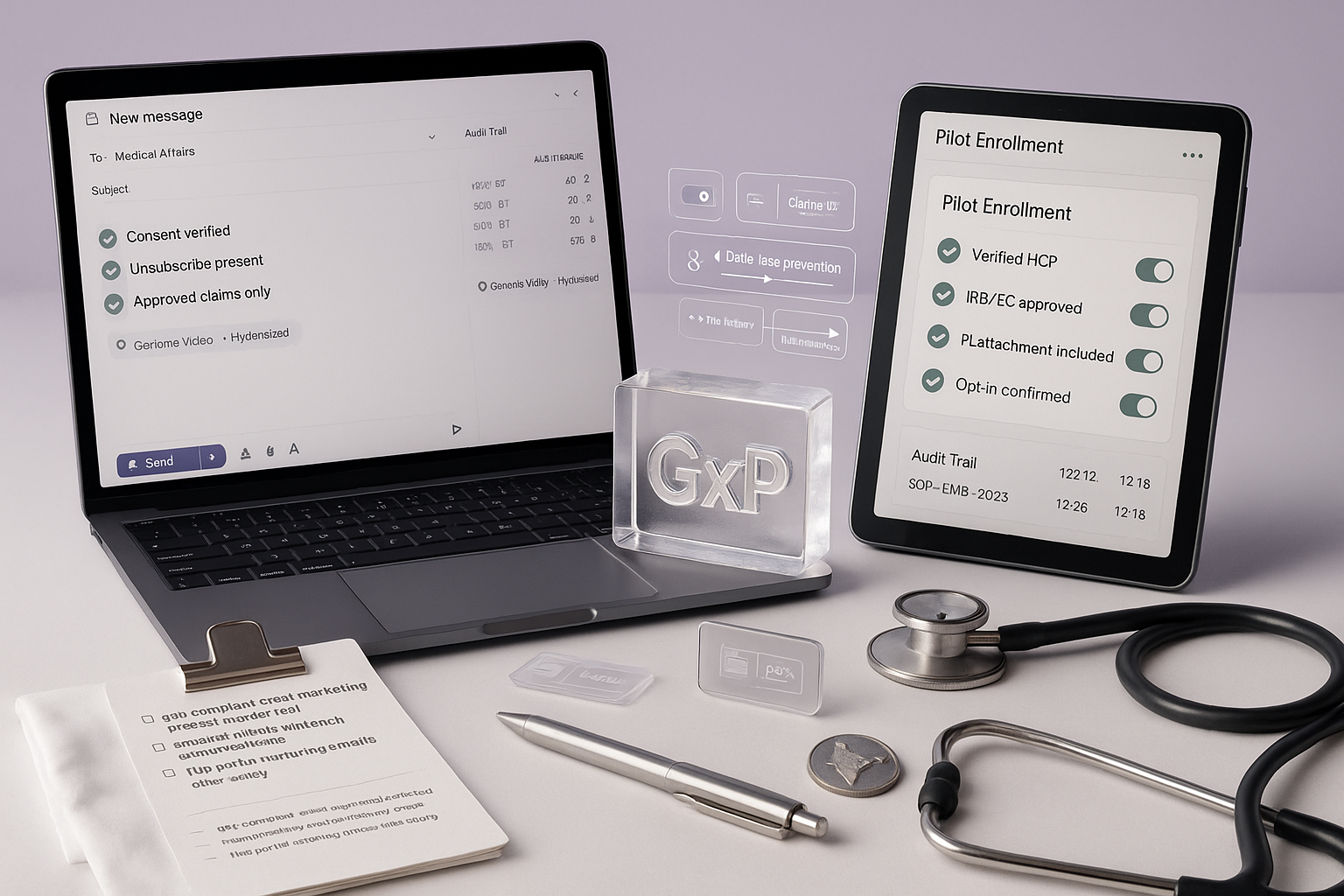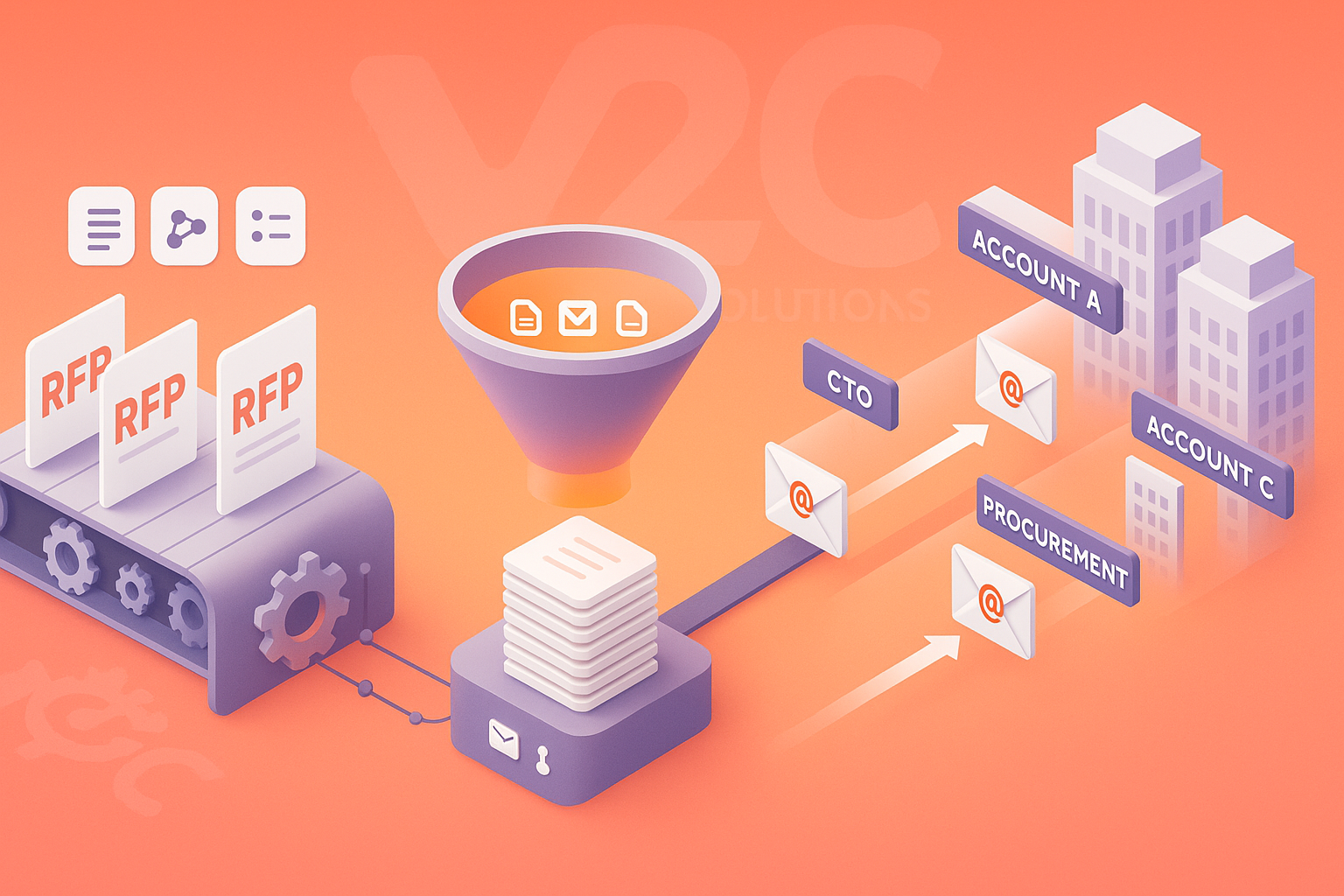When most teams hear “medical-legal-regulatory review,” they think delays. At Way2Connect Solutions, we see leverage. In this anonymized case study, our client—a mid-market specialty pharma based in Genome Valley, Hyderabad—needed email to do three hard things at once: respect MLR/PV rules, reach real HCPs beyond hospital filters, and progress conversations toward structured pilot studies led by Medical Affairs. The outcome: compliant sequences that earned high-quality replies, calendar time with the right stakeholders, and green-lit pilots on a predictable cadence.
The Reality We Walked Into
- Fragmented assets & claims. Brand, Med Affairs, and Regulatory each had their own versions of content. No shared “approved claims bank,” no audit trail linking copy to source.
- Deliverability drag. Image-heavy templates died in hospital gateways; link farms and “marketing tone” triggered security filters.
- Consent & preference gaps. HCP opt-in/opt-out states and specialty preferences weren’t tidy, risking non-compliant outreach.
- Vague outcomes. Email was “sent,” but not tied to conversations, protocol feedback, or pilot acceptance.
Our thesis was simple: treat compliance as a product feature—design for it up front—and growth becomes easier, not harder. This is what we mean by gxp compliant email marketing pharma hyderabad done right.
The Playbook (Built for Med Affairs, Approved by MLR)
1) Create the Approved Claims Bank
We centralized on-label claims, fair-balance statements, references, and FAQs in a versioned repository. Each email block (headline, benefit, risk, CTA) mapped back to a source ID and review outcome. This let Medical Affairs assemble messages from pre-approved parts, reducing rework and risk.
Why it matters: Every sentence knows its source; every change leaves a trail.
2) Consent, Identity, and Preferences
We rebuilt the HCP list with verified identity (specialty, institution, language), captured consent states with timestamped logs, and enforced specialty-specific exclusions at the ESP level. Unsubscribe, manage-preferences, and AE/PV reporting links were visible and tested on **slow mobile**.
Why it matters: Respecting consent and role relevance isn’t just the law—it’s the fastest way to a reply.
3) The medical affairs outreach sequence india
We designed a 5-touch, value-led series aimed at scientific conversation, not sales:
1. Touch 1: “Why now” evidence note (plain-text) — one key data point, one question, zero fluff.
2. Touch 2: Methods & protocol primer — short schematic, link to gated methods brief on the HCP portal.
3. Touch 3: KOL signal — ethically framed summary of peer experience; no brand claims beyond label.
4. Touch 4: Implementation logistics — site criteria, time ask, staff roles; calendar embed to pick a 15-min slot.
5. Touch 5: Pilot invitation — checklist + consent form preview; route responses to Medical Affairs with AE/PV monitoring.
All sends used “styled plain-text” (HTML minimalism), 550–600px width, short subject lines, and a single call-to-action.
4) The hcp portal nurturing emails case study backbone
Email was the door; the HCP portal was the room. We stood up a minimal, compliance-ready portal with:
- Role-based access (HCP vs. admin) and audit logs
- Document locker (IFU, SmPC, fair balance, references)
- Micro-modules: protocol walk-through, short videos with transcripts, and AE/PV reporting banner
- Localization toggles for sites outside India
- “Book discussion” widget directly to Medical Affairs calendars
- Nurture emails deep-linked to specific portal sections, not a generic homepage.
5) Deliverability Engineering
We pruned links, reduced images, and used branded domains with aligned SPF/DKIM/DMARC. CTAs pointed to a single, stable domain. We A/B tested signature formats (short wins), placement of the AE/PV footer (always visible, never buried), and removed tracking pixels for institutions that block them.
What Changed (Signals That Matter)
More real replies. Messages started with method questions (“Do you have renal subgroup data?”) rather than “Unsubscribe.”
Committee velocity. Medical Affairs gained introductions to PIs and department leads without going through brand-led back-and-forth.
Pilot traction. Discussions progressed from email to portal to protocol review to calendar, with clean handoffs and audit trails.
We don’t publish client-specific numbers here, but the pattern was consistent: fewer sends, stronger conversations, shorter time to “pilot consideration.” That’s the essence of gxp compliant email marketing pharma hyderabad as a growth system.
The Stack (Lightweight, Auditable)
Claims Bank & Workflows: Versioned docs with approver stamps; reviewer comments resolved before build
ESP & Routing: Plain-text-first templates; persona-based segments; AE/PV mailbox monitoring
HCP Portal: Role-based access, document tracking, consent logs, and meeting scheduler
Analytics: Event labels for “reply with question,” “calendar booked,” “portal protocol viewed,” linked back to sequence/touch
No exotic software—just disciplined architecture and review hygiene.
Copy Rules We Don’t Break
- Lead with science. Every claim anchored to a reference ID.
- One job per email. If it’s a protocol note, it doesn’t sell features.
- Clear paths. AE/PV reporting always one click away; unsubscribe honored instantly.
- Respect the inbox. Short subjects, human tone, no marketing gloss.
What This Means for Hyderabad Pharma Teams
If you operate in or around Hyderabad’s Genome Valley, your inbox reality is the same: tight review cycles, savvy HCPs, and institutional filters. The win isn’t louder design; it’s tighter compliance design. When you architect medical affairs outreach sequence India with an HCP portal behind it, you create legitimate reasons to talk—and a compliant way to say yes.
This piece is your hcp portal nurturing emails case study blueprint: start with a claims bank, enforce consent and preferences, write for deliverability, and make Medical Affairs the hero. Way2Connect Solutions builds that loop end-to-end—so your next “compliance hurdle” becomes your fastest path to pilot.
It is email outreach designed to meet pharma regulations (MLR/PV), with approved claims, consent tracking, and audit trails—built to start scientific conversations with Medical Affairs and HCPs in and around Hyderabad’s Genome Valley.
By centralizing on-label claims, fair balance, references, and FAQs into versioned, pre-approved blocks. Each email section maps to a source ID, so reviewers validate components once and reuse them safely.
A 5-touch, science-first flow: evidence note, methods primer, ethical KOL signal, implementation logistics with calendar embed, and a pilot invitation with checklists—each with a single, clear CTA.
HCP identity is verified and consent states are time-stamped. Specialty exclusions are enforced at the ESP level. Unsubscribe, manage-preferences, and AE/PV reporting links remain visible and functional on mobile.
The portal provides role-based access to IFU/SmPC, fair balance, protocol walk-throughs, transcripts, and AE/PV banners, plus a scheduler to book Medical Affairs time—emails deep-link to specific modules.



